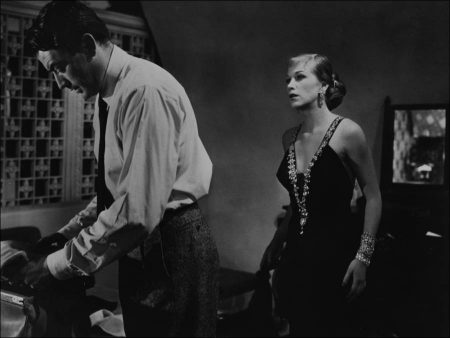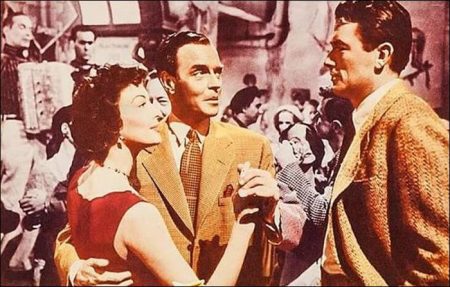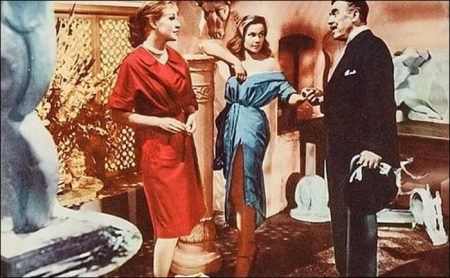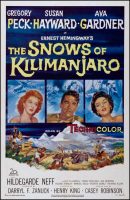Taglines: his adventures… like his loves… were ğgreat and exciting!
The Snows of Kilimanjaro movie storyline. As writer Harry Street lays gravely wounded from an African hunting accident he feverishly reflects on what he perceives as his failures at love and writing. Through his delirium he recalls his one true love Cynthia Green who he lost by his obsession for roaming the world in search of stories for his novels. Though she is dead Cynthia continues to haunt Street’s thoughts.
In spite of one successful novel after another, Street feels he has compromised his talent to ensure the success of his books, making him a failure in his eyes. His neglected wife Helen tends to his wounds, listens to his ranting, endures his talk of lost loves, and tries to restore in him the will to fight his illness until help arrives. Her devotion to him makes him finally realize that he is not a failure. With his realization of a chance for love and happiness with Helen, he regains his will to live.
The Snows of Kilimanjaro is a 1952 American Technicolor film based on the 1936 short story of the same name by Ernest Hemingway. The film version of the short story was directed by Henry King, written by Casey Robinson, and starred Gregory Peck as Harry, Susan Hayward as Helen, and Ava Gardner as Cynthia Green (a character invented for the film). The film’s ending does not mirror the story’s ending.
Considered by Hemingway to be one of his finest stories, “The Snows of Kilimanjaro” was first published in Esquire magazine in 1936 and then republished in The Fifth Column and the First Forty-Nine Stories (1938). The film was nominated for two Oscars at the 25th Academy Awards, for Best Cinematography, Color and Best Art Direction, Color (Lyle R. Wheeler, John DeCuir, Thomas Little, Paul S. Fox). The film has entered the public domain.
The film was shot on location in Nairobi, Kenya, Cairo, Egypt, and the French Riviera, and studio work was done at Stage 14 in 20th Century Fox Studios. During production, on April 8, 1952, when Peck was carrying Gardner for a scene in the film, Peck wrenched his knee and production had to be postponed for 10 days while he recovered in his Pacific Palisades home, and Hildegard Knef came down with influenza in the studios. She was able though to sing two Cole Porter tunes in the film. Jazz musician Benny Carter performs early on in the film. The bullfight sequences were archive footage, taken from Fox’s 1941 film Blood and Sand.
About the Story
The film begins with the opening words of Hemingway’s story: “Kilimanjaro is a snow-covered mountain 19,710 feet high, and is said to be the highest mountain in Africa. Its western summit is called the Masai ‘Ngje Ngi,’ the House of God. Close to the western summit there is the dried and frozen carcass of a leopard. No one has explained what the leopard was seeking at that altitude.”[4]
The story centers on the memories of disillusioned writer, Harry Street, who is on safari in Africa. He has a severely infected wound from a thorn prick, and lies outside his tent awaiting a slow death, though in the film it is pointed out he may have acquired the infection from leaping into a muddy river to rescue one of the safari’s porters from a hippo after he falls in the river. His female companion, Helen, nurses Harry and hunts game for the larder.
The loss of mobility brings self-reflection. In an often delirious state he remembers his past relationship with Cynthia Green, whom he met in Paris as members of the “Lost Generation.” Upon the sale of Harry’s first novel, rather than rent a nicer home, Harry wishes to go on safari to Africa. There he has his happiest moments, including bagging a rhino. Cynthia is pregnant, but worries about sharing this news with Harry, who is passionate about his travels and work as a journalist and author. Harry only learns about the pregnancy after her miscarriage. Suffering depression and sinking into alcoholism, she eventually leaves Harry for a flamenco dancer when she believes Harry is off for a job as a war correspondent.
Harry later becomes engaged to the wealthy and socially connected Countess Elizabeth, whom he meets on the Cote d’Azur; however, he still remains loyal to the memory of Cynthia. On the eve of their wedding, a jealous Elizabeth confronts Harry with a letter to Harry sent from Cynthia, who is now in Madrid. Elizabeth destroys the letter in front of Harry who stalks off to go to Spain. Unable to find Cynthia at the Madrid address on the envelope, he enlists to fight in the Spanish Civil War. During a battle he meets Cynthia, who is now an ambulance driver. Cynthia is mortally wounded, and Harry is shot and wounded when he deserts the battle to try to bring the dying Cynthia to a doctor.
Harry returns to Paris. While he is standing on the bridge watching the river, he meets Helen, who reminds him of Cynthia. After the death of his beloved mentor Uncle Bill, Harry receives as a bequest a letter from his uncle that gives him the riddle of the leopard. Harry’s bartender suggests that the leopard ended up there as he was on a false scent and became lost, but Harry takes Helen on a safari to Kenya to learn the answer of the riddle.
He is injured and develops an infection. As Harry nears death, the protective Helen fights off a witch doctor. Following the directions in an emergency first aid manual, she opens Harry’s wound to release the infection. At the dawn a medical party arrives by airplane. The vultures and hyena who have been awaiting Harry’s death leave and never return. Harry realizes his love for Helen.
The Snows of Kilimanjaro (1952)
Directed by: Henry King
Starring: Gregory Peck, Ava Gardner, Susan Hayward, Hildegard Knef, Torin Thatcher, Ava Norring, Helene Stanley, Marcel Dalio, Vicente Gómez, Richard Allan, Amanda Ambrose, Nina Borget
Screenplay by: Casey Robinson
Cinematography by: Leon Shamroy
Film Editing by: Barbara McLean
Set Decoration by: Paul S. Fox, Thomas Little
Art Direction by: John DeCuir, Lyle R. Wheeler
Music by: Bernard Herrmann
MPAA Rating: None.
Distributed by: 20th Century Fox
Release Date: September 17, 1952 (New York)
Views: 192



